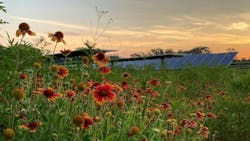Bayer Installs 2.7 MW Solar and Storage System to Power Vegetable Research and Development Site in California
Bayer has announced the installation of a 2.7 MW solar and 1 MW energy storage system at its vegetable research and development (R&D) site in Woodland, California, to provide 70% of the site’s electrical energy demand.
According to the company, Bayer’s vegetable R&D site develops healthy vegetable varieties through new solutions that achieve a more sustainable harvest, including more efficient irrigation and fertilization, companion cropping, and increased carbon dioxide removal.
The solar installation, completed in partnership with Enel North America, occupies 10 of the 210 acres of company-owned property. The system utilizes ground-mounted solar panels capable of generating nearly 2 MW of electricity.
To complement the solar array, Bayer also installed a bank of batteries to serve as excess power storage, which will be used to offset evening peak power demand when solar generation decreases.
“This project is a great example of Bayer’s commitment to achieve a 42% reduction in greenhouse gas emissions by 2030,” said Staci Rosenberger, Woodland Site Operations Lead at Bayer. “With this investment, we will reduce our impact on the environment and offset electrical usage during peak demand, benefiting not only our company but surrounding communities as well.”
Located in a region historically prone to rolling blackouts and grid disruptions, this solar-plus-storage system will increase Bayer’s energy and operational resiliency while reducing the company’s carbon footprint and demand on the local energy infrastructure.
“The growing prevalence of extreme weather and wildfires has underscored the need for more resilient energy solutions,” said Matt Barnes, Head of Distributed Energy Solutions at Enel North America.
“This project will not only increase Bayer’s energy resilience but will also help reduce demand on often-stressed local energy infrastructure, benefiting all energy users in the region,” added Barnes.
During the solar project’s estimated 30-year life, Bayer will also plant flowering cover crops, such as wildflowers, between the rows of panels to create pollinator habitats and for soil remediation purposes.
About the Author
Breanna Sandridge, Senior Editor
Breanna Sandridge is senior editor for EnergyTech and Microgrid Knowledge, both part of the energy group at Endeavor Business Media.
Prior to that, Breanna was managing editor for Machinery Lubrication and Reliable Plant magazines, both part of Noria Corp. She has two years experience covering the industrial sector.
She also is a 2021 graduate of Northeastern State University (Oklahoma) with a Bachelor's in English.
